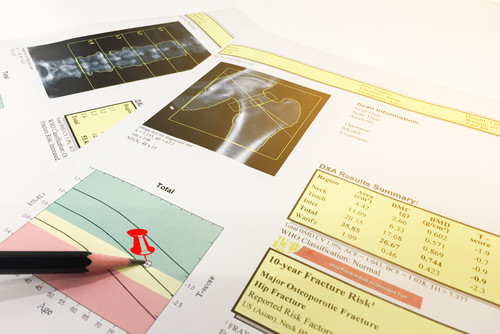The Centers for Advanced Orthopaedics is redefining the way musculoskeletal care is delivered across the region with locations throughout Maryland, DC, Virginia and Pennsylvania.
Osteoporosis: An overview
 Osteoporosis is a condition in which the ratio of creation of new bone is less than the reabsorbing of old bone. This imbalance can cause bones to become brittle and make the skeletal system more vulnerable to insult. It can impact both men and women however it tends to be more prevalent in females; white, of Asian descent, and postmenopausal. Some other factors that have shown a greater predisposition to this condition are: family history, small body frame, advancing age, the taking of certain medications, specific medical conditions, and long term confinement to bed.
Osteoporosis is a condition in which the ratio of creation of new bone is less than the reabsorbing of old bone. This imbalance can cause bones to become brittle and make the skeletal system more vulnerable to insult. It can impact both men and women however it tends to be more prevalent in females; white, of Asian descent, and postmenopausal. Some other factors that have shown a greater predisposition to this condition are: family history, small body frame, advancing age, the taking of certain medications, specific medical conditions, and long term confinement to bed.
Research has shown that there are ways to aid in the prevention or combat the progression of osteoporosis. These include not smoking, avoidance of excessive alcohol intake, and adhering to a healthy, well balanced diet. It is important that a diet is inclusive of calcium and vitamin D, either by food source or, if necessary, by supplements. A person should always seek guidance from his/her physician to make sure that the regimen is appropriate for one's current condition.
Another very important component is to incorporate a strengthen program for the muscles/bones of the upper extremities and upper spine (hand weights and resistance bands), and a strengthening/weight bearing program for the lower extremities and lower spine. Weight bearing exercises such as walking, yoga, and dancing are more effective in influencing healthy bone density than activities such as swimming and cycling.
A bone density study (DEXA scan) can help your doctor determine the integrity of your bones. Based on the results of the exam your physician can determine if additional interventions are necessary, such as medication (most common are the Bisphosphonates) or hormone related therapy.
It is essential to stay vigilant in determining how to manage osteoporosis properly to prevent more detrimental conditions such as fractures. Attention to your surrounding environment is imperative to prevent falls. Keeping your living space free of obstacles such as throw rugs and electrical cords is a proactive step to safety. Additional items such as grab bars in the bathroom and handrails on all stairways can be very helpful.
Accessing individuals in the medical field (Doctors, Physical Therapists, Occupational Therapists, Nutritionists) for assistance in navigating through this process can be very beneficial.